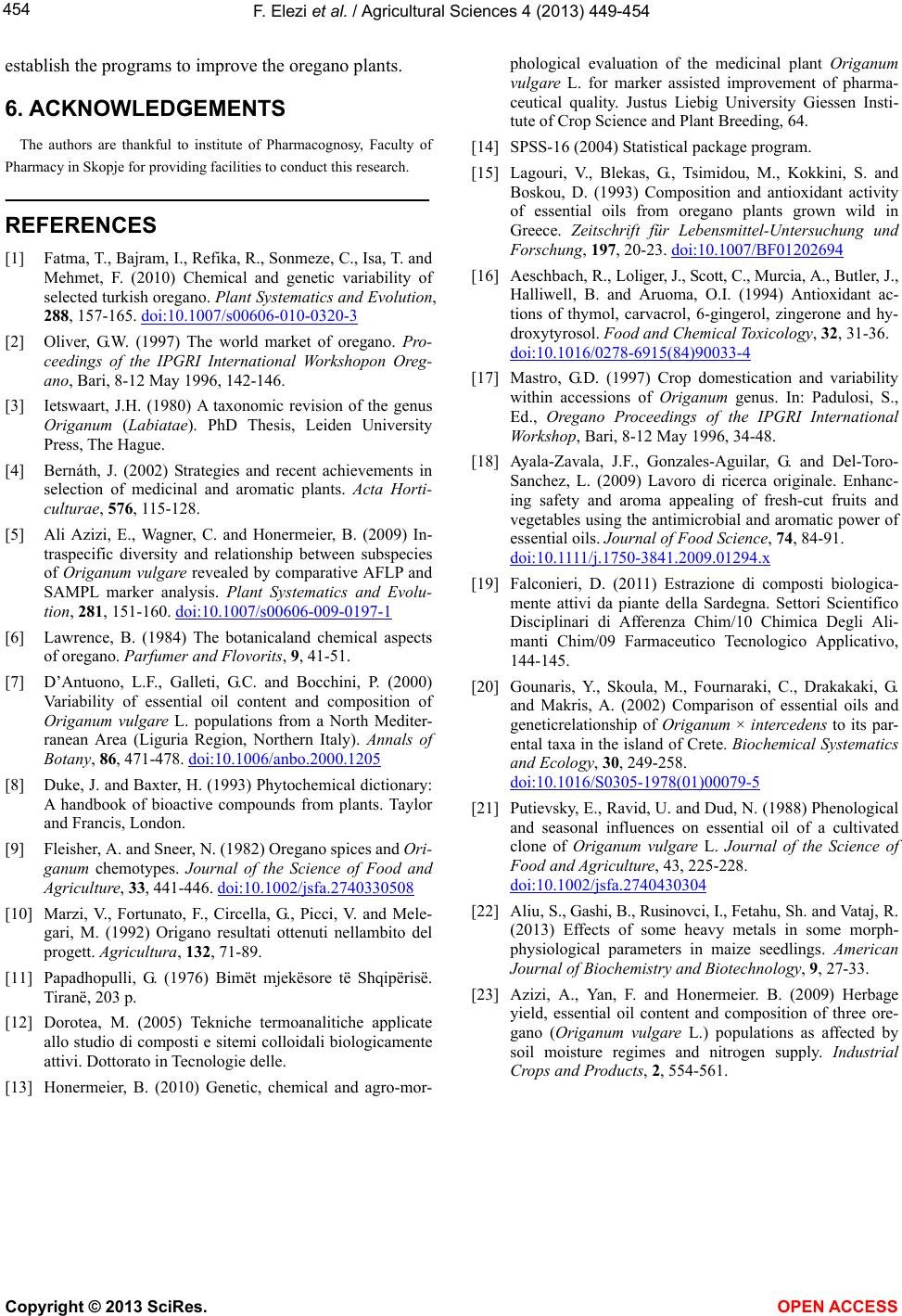
F. Elezi et al. / Agricultural Sciences 4 (201 3) 449-454
454
establish the programs to improve the oregano plants.
6. ACKNOWLEDGEMENTS
The authors are thankful to institute of Pharmacognosy, Faculty of
Pharmacy in Skopje for providing facilities to conduct this research.
REFERENCES
[1] Fatma, T., Bajram, I., Refika, R., Sonmeze, C., Isa, T. and
Mehmet, F. (2010) Chemical and genetic variability of
selected turkish oregano. Plant Systematics and Evolution,
288, 157-165. doi:10.1007/s00606-010-0320-3
[2] Oliver, G.W. (1997) The world market of oregano. Pro-
ceedings of the IPGRI International Workshopon Oreg-
ano, Bari, 8-12 May 1996, 142-146.
[3] Ietswaart, J.H. (1980) A taxonomic revision of the genus
Origanum (Labiatae). PhD Thesis, Leiden University
Press, The Hague.
[4] Bernáth, J. (2002) Strategies and recent achievements in
selection of medicinal and aromatic plants. Acta Horti-
culturae, 576, 115-128.
[5] Ali Azizi, E., Wagner, C. and Honermeier, B. (2009) In-
traspecific diversity and relationship between subspecies
of Origanum vulgare revealed by comparative AFLP and
SAMPL marker analysis. Plant Systematics and Evolu-
tion, 281, 151-160. doi:10.1007/s00606-009-0197-1
[6] Lawrence, B. (1984) The botanicaland chemical aspects
of oregano. Parfumer and Flovorits, 9, 41-51.
[7] D’Antuono, L.F., Galleti, G.C. and Bocchini, P. (2000)
Variability of essential oil content and composition of
Origanum vulgare L. populations from a North Mediter-
ranean Area (Liguria Region, Northern Italy). Annals of
Botany, 86, 471-478. doi:10.1006/anbo.2000.1205
[8] Duke, J. and Baxter, H. (1993) Phytochemical dictionary:
A handbook of bioactive compounds from plants. Taylor
and Francis, London.
[9] Fleisher, A. and Sneer, N. (1982) Oregano spices and Ori-
ganum chemotypes. Journal of the Science of Food and
Agriculture, 33, 441-446. doi:10.1002/jsfa.2740330508
[10] Marzi, V., Fortunato, F., Circella, G., Picci, V. and Mele-
gari, M. (1992) Origano resultati ottenuti nellambito del
progett. Agricultura, 132, 71-89.
[11] Papadhopulli, G. (1976) Bimët mjekësore të Shqipërisë.
Tiranë, 203 p.
[12] Dorotea, M. (2005) Tekniche termoanalitiche applicate
allo studio di composti e sitemi colloidali biologicamente
attivi. Dottorato in Tecnologie delle.
[13] Honermeier, B. (2010) Genetic, chemical and agro-mor-
phological evaluation of the medicinal plant Origanum
vulgare L. for marker assisted improvement of pharma-
ceutical quality. Justus Liebig University Giessen Insti-
tute of Crop Science and Plant Breeding, 64.
[14] SPSS-16 (2004) Statistical package program.
[15] Lagouri, V., Blekas, G., Tsimidou, M., Kokkini, S. and
Boskou, D. (1993) Composition and antioxidant activity
of essential oils from oregano plants grown wild in
Greece. Zeitschrift für Lebensmittel-Untersuchung und
Forschung, 197, 20-23. doi:10.1007/BF01202694
[16] Aeschbach, R., Loliger, J., Scott, C., Murcia, A., Butler, J.,
Halliwell, B. and Aruoma, O.I. (1994) Antioxidant ac-
tions of thymol, carvacrol, 6-gingerol, zingerone and hy-
droxytyrosol. Food and Chemical Toxicology, 32, 31-36.
doi:10.1016/0278-6915(84)90033-4
[17] Mastro, G.D. (1997) Crop domestication and variability
within accessions of Origanum genus. In: Padulosi, S.,
Ed., Oregano Proceedings of the IPGRI International
Workshop, Bari, 8-12 May 1996, 34-48.
[18] Ayala-Zavala, J.F., Gonzales-Aguilar, G. and Del-Toro-
Sanchez, L. (2009) Lavoro di ricerca originale. Enhanc-
ing safety and aroma appealing of fresh-cut fruits and
vegetables using the antimicrobial and aromatic power of
essential oils. Journal of Food Science, 74, 84-91.
doi:10.1111 /j.1750-3841.2009.01294.x
[19] Falconieri, D. (2011) Estrazione di composti biologica-
mente attivi da piante della Sardegna. Settori Scientifico
Disciplinari di Afferenza Chim/10 Chimica Degli Ali-
manti Chim/09 Farmaceutico Tecnologico Applicativo,
144-145.
[20] Gounaris, Y., Skoula, M., Fournaraki, C., Drakakaki, G.
and Makris, A. (2002) Comparison of essential oils and
geneticrelationship of Origanum × intercedens to its par-
ental taxa in the island of Crete. Biochemical Systematics
and Ecology, 30, 249-258.
doi:10.1016/S0305-1978(01)00079-5
[21] Putievsky, E., Ravid, U. and Dud, N. (1988) Phenological
and seasonal influences on essential oil of a cultivated
clone of Origanum vulgare L. Journal of the Science of
Food and Agriculture, 43, 225-228.
doi:10.1002/jsfa.2740430304
[22] Aliu, S., Gashi, B., Rusinovci, I., Fetahu, Sh. and Vataj, R.
(2013) Effects of some heavy metals in some morph-
physiological parameters in maize seedlings. American
Journal of Biochemistry and Biotechnology, 9, 27-33.
[23] Azizi, A., Yan, F. and Honermeier. B. (2009) Herbage
yield, essential oil content and composition of three ore-
gano (Origanum vulgare L.) populations as affected by
soil moisture regimes and nitrogen supply. Industrial
Crops and Products, 2, 554-561.
Copyright © 2013 SciRes. OPEN ACCE SS